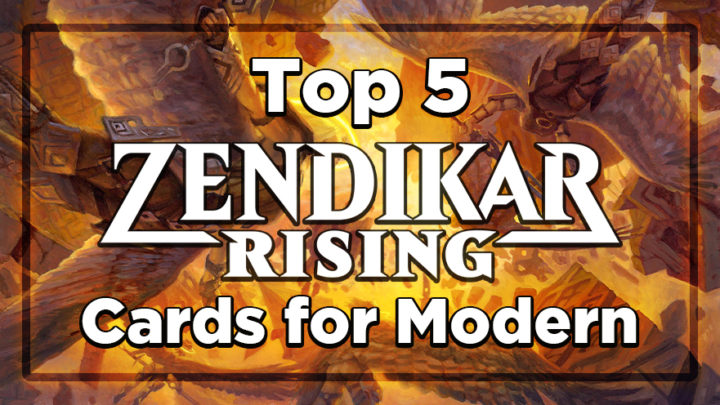Wow, I can’t believe that Zendikar Rising is already here! Naturally, as I do with each new set, I sat down and found what I believe are the best five cards for Modern. Zendikar Rising was a bit tougher than previous sets, as the party and kicker mechanics don’t translate well into eternal formats. That left two categories: cards that add something unique to Magic, or cards that are more efficient than similar cards. Luckily, we have solid options in both camps.
The Mythic DFC Land Cycle
This cycle of double-faced lands is not only a groundbreaking use of design space, but also criminally underrated in power level. I’ve seen a lot of discussion online about how these cards are not good enough or too expensive. But these cards are more than the sum of their parts. When you staple a B to a B, the result is higher than a B by virtue of flexibility. Split cards have historically had the issue of being too over-costed to offset the benefits of choice, and they almost always failed to be excellent early plays by design. When one half of the split card is a land with the ability to come into play untapped, nearly all of the risk is eliminated, assuming your mana base can support single-colored lands.
Of these five cards, I expect Turntimber Symbiosis, Emeria’s Call, and Agadeem’s Awakening to find homes quickly. It may be awhile before Shatterskull Smashing and Sea Gate Restoration see play, but if any heavy red or blue decks want them, they’ll get to add them at a minimal opportunity cost.
Turntimber Symbiosis
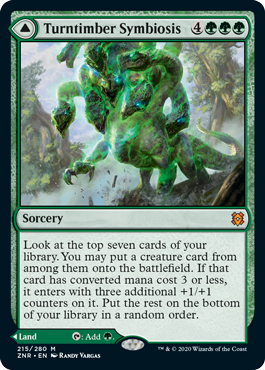
Turntimber Symbiosis seems like it has a solid home in Amulet Titan. A combo deck without any other pain built into the mana base will appreciate an untapped green source, even if it comes at a cost. That being said, Amulet has never really minded tap lands all that much because of… well, Amulet of Vigor, which mitigates the “downside” even further. The real kicker, though, is that you can retain the high land count that Amulet Titan currently supports while reducing both of the fail rates — flooding out and failing to find a Primeval Titan. I’d expect to see a fair number of copies of Turntimber Symbiosis in Primeval Titan decks going forward.
Emeria’s Call
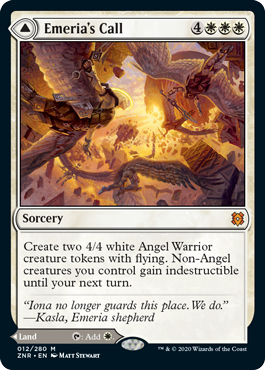
A couple weeks ago, I talked about the virtue of Shark Typhoon — a card that lets control decks win the game without the risk of having a card in the deck that is devoted to winning the game. Emeria’s Call functions similarly, but with even less risk; instead of cycling a card early to dig for a land, you just get a land. Seven mana may seem a bit steep, but you’re actually getting more bang for your buck out of a pair of 4/4 angels than you would with a single 5/5 shark. Now don’t get me wrong: I’m not saying you should replace Shark Typhoon with Emeria’s Call, but Azorius Control players will want as many “wins the game without needing to be a card that wins the game” cards as they can get. That means taking a hard look at your mana base to figure out how many copies you can afford to play.
Agadeem’s Awakening
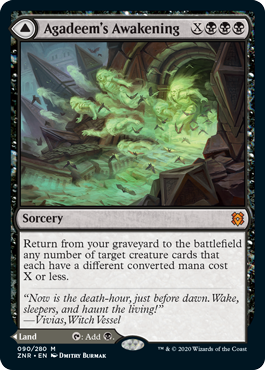
Agadeem’s Awakening is somewhat tough to parse in Modern, as I don’t think it has an obvious home. But, if you ask me, that unknown is fascinating. The Jund/Rock/Death’s Shadow decks of the world are likely interested in small numbers of Agadeem’s Awakening to be able to grind harder at little cost. Things start getting interesting when you explore Agadeem’s Awakening as an enabler in Death’s Shadow, or better yet, as a combo piece in a deck that sacrifices its own creatures for fun and profit. I’m unsure what exactly those decks will look like, but I’d be shocked if some sort of creature-based combo deck isn’t interested in Agadeem’s Awakening.
Feed the Swarm
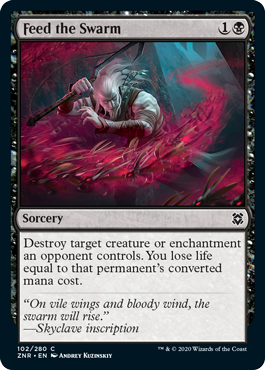
Continuing with unique additions to Magic, we have Feed the Swarm — the first piece of black enchantment removal ever. While Feed the Swarm isn’t jump-off-the-page powerful, it will surely have an impact on Modern. No longer are black decks forced to adopt green for Abrupt Decay or Assassin’s Trophy if they want to be able to kill an enchantment. Grixis decks are the real winners with this, one as none of the colors that comprise it could effectively answer an enchantment before.
Feed the Swarm is likely to be a sideboard card, and maybe an unpopular one at first, but its very existence takes a lot of pressure off of black midrange decks going forward. Plus, it’s nice to have access to a removal spell that kills Kor Spiritdancer, Dryad Arbor, and the enchantments out of Bogles, which can make sideboarding a lot easier.
Cleansing Wildfire
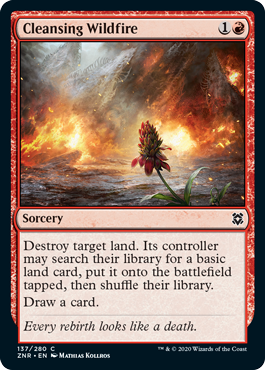
For years, interactive decks have been searching for a way to interact with Tron and other “big mana” strategies as cheaply as possible. Fulminator Mage, Blood Moon and Molten Rain all cost three, which makes them a liability against Tron on the draw. Your Fulminator Mage isn’t going to be all that powerful if there’s already a Karn Liberated or a Primeval Titan on the battlefield.
Cleansing Wildfire is a powerful hate card that doesn’t leave either player feeling shorted. Now, you can interact meaningfully when you’re on the draw, and you may not have to spend your whole turn destroying a land on the play. Plus, you get to draw a card and your opponent gets a basic land, so both of you can continue playing a reasonable game. It’s hard to design hate cards that impact the game without completely locking a player out, and Wizards really nailed it with this one. Expect to see Cleansing Wildfire out of the sideboard of any midrange strategy with red.
Magmatic Channeler

Magmatic Channeler is a bit of a doozy. A two-mana 1/3 isn’t particularly impressive, but getting four instants and/or sorceries into the graveyard isn’t too difficult. Expect this to be a 4/4 more often than not.
Scaling two-drops that are good in combat and provide value later into the game screams Jund. While it won’t usurp Tarmogoyf’s spot, I do think it could make a strong teammate with our lhurgoyf friend. Jund has been looking to replace Dark Confidant for some time, and Magmatic Channeler is a strong candidate to do so. Turning every dead card in your hand into a pseudo-Sleight of Hand is a lot for a 4/4 to do outside of the red zone, plus it helps enable itself. Since Modern Horizons, we’ve also seen Rakdos midrange decks coalesce around Lightning Skelemental and Seasoned Pyromancer; Magmatic Channeler provides the consistent threat that these decks have been searching for to try and transition from early to mid-game.
Scourge of the Skyclaves
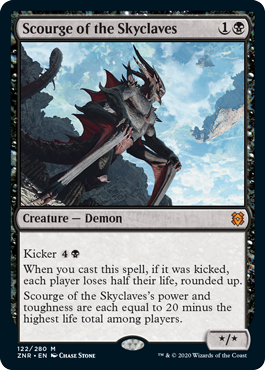
Last week, I wrote about Scourge of the Skyclaves, primarily through a Death’s Shadow lens. The potency and efficiency of Scourge of the Skyclaves is undeniable, but its uses are fairly narrow; you need to be interested in lowering both players’ life totals to really capitalize on it. That said, as I mentioned last week, Death’s Shadow may not be the only deck that can benefit from this card.
Sultai Midrange has been on the bubble in Modern for some time, but lacks closing power besides Tarmogoyf. Perhaps Scourge of the Skyclaves is good enough for the decks that either don’t have access to Tarmogoyf or need the redundancy of a second Tarmogoyf-like creature. Orzhov Stoneblade could also use another solid two-drop, and perhaps even a Rakdos Burn shell with Eidolon of the Great Revel can supercharge Scourge of the Skyclaves.
Conclusion
There is so much to chew on with Zendikar Rising, particularly because it will challenge the conventional wisdom of deck-building with modal DFC’s. How many is it correct to add to your deck? Will decks trend toward playing fewer colors in order to be able to play more of them? Will we see a drop in basic lands as players slot these into existing decks? These are all hard questions that require rigorous testing to answer.
What card(s) are you most excited for in Zendikar Rising? Maybe you have a deck that you’re excited to share? I’d love to hear your answers on Twitter — let me know at @RappaciousOne! I’ll see you all in the MTGO trenches this weekend — happy brewing!

Michael Rapp is a Modern specialist who favors Thoughtseize decks. Magic sates his desire for competition and constant improvement.

